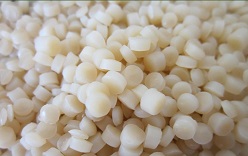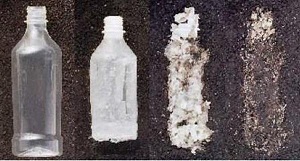PHAs are a family of naturally occurring polymers – no plastics in the usual sense of the word, but energy reserves of microorganisms. A very versatile family: we can process them to hard or soft plastics, and to both crystalline and amorphous polymers. And, very important: all members of the PHA family are biodegradable; not just in industrial composting equipment, but also in the soil and in freshwater and seawater – the only other plastics family with those properties are starch plastics.

As yet, PHA production worldwide is very low, and yet this plastic has a very large potential. PHAs (full name: polyhydroxyalkanoates) are not produced, like most plastics, by connecting molecules in a reactor with the assistance of a catalyst, but by microorganisms, that synthesise the compound in their cells. In the nineties, some companies tried to market PHAs and failed; plastics marketers have become weary of them ever since. Companies developing the plastic have tried in vain for a long time to market it on the basis of its biodegradability. According to Jan Ravenstijn, a well-known consultant in the area of bioplastics who chaired a session on PHA at the Bio-Based Materials conference in Cologne last April, they neglected the laws of polymer marketing in doing so. In bioplastics marketing, quality and price come first; only if a PHA fulfils the necessary price/quality ratio requirements, biodegradability will lend an extra and strong sales argument.
Alliances in the value chain
PHAs are very easy to process. They can be blown and moulded, foamed and processed into yarns. They make excellent packaging materials, also for food packaging. They can be printed, sealed, painted. Mixing with other plastics will often improve the qualities of the latter. Because of its large variety, PHA can substitute almost all major plastics in many of their applications: polyethylene, polypropylene, polystyrene, PVC, PET. PHAs can be processed to glues. Some kinds of PHA can be used as implants, the material will be entirely resorbed by the body in the course of time. There seems to be just one impediment: price. This is too high yet for most applications. What can producers do about that?

One of the most important options open to producers, Jan Ravenstijn said in his Cologne speech, is to form alliances in the value chain. Continually, all links in these chains need improvement. Raw materials suppliers aim for increasing the value of their (waste) streams; compounders and part manufacturers aim for good processing performance; markets aim for new product functionality and/or a good brand image; consumers aim for biodegradability performance and environmental advantages. Ravenstijn specifically mentioned Bio-On, Newlight Technologies and TerraVerdae as companies that put much effort into the build-up of their networks. On this site, we discussed earlier the remarkable agreement of Newlight Technologies with IKEA. And Mango Materials, a company that pursues another strategy and produces PHA from CH4, produced as a waste gas from sites like landfills and abandoned coal mines. Others develop ways to produce PHAs from fatty acids in wastewater streams of the food industry or from sewage stations.
PHA has special properties
In Cologne, some companies highlighted the special properties of their PHA. Metabolix specialises in PHA copolymers. Together with PLA, it produces a plastic that can compete with HDPE. And in a mix with biopolymers, PHAs improve biodegradability. Bioplastech, a spin-off of the University of Dublin, produces PHA from plastic waste through bacteria. KANEKA, a major Japanese plastic producer, develops varieties with good heat-resistant properties (e.g. for plastic cups) and varieties that can be used as a biodegradable agricultural plastic. Spanish AIMPLAS develops fire-resistant PHA panels for the automotive industry. And levulinic acid improves PHA properties, according to GF Biochemicals, that produces and markets biobased levulinic acid.
All said, the PHA sector should not leave out of sight the advantages of biodegradability, according to Jan Ravenstijn. The sector should always highlight that plastics have and end-of-life phase. What will happen if the product breaks down, or is discarded because it is no longer useful? The problem of the plastic soup in the oceans is staggering. In nature, ordinary plastics break down to little unnoticeable fragments that can easily enter into the food chain, according to Christian Bonten of the Institut für Kunststofftechnik IKT. We should not allow them to escape, they should be controlled and recycled. But at present over 85% of all packaging materials are discarded to the environment, which equals 1 to 2 truckloads of plastic each minute (right now; without any subsequent action, this might be 3 to 4 times as much in 2050). Biodegradable plastics like PHA will be at least part of the solution to that problem.
Interesting? Then also read:
PHAs on the rise: for the first time, demand outstrips supply
Mycelium, the ultimate green material
Bioplastics: end the confusion

Hi Can you tell me if PHA needs to be put in an industrial composter to biodegrade please? If left in the environment or landfill how long will it take to biodegrade then? Thank you.
The decomposition testing has a big flaw, the article under test is always placed in perfect soil, and not in a medium of other manmade waste such as what actually happens in landfills. Does the testing ever include anaerobic conditions where there is no actual dirt present, just a medium of other materials such as newspaper & petrochemical plastics? I suspect a lot of these ‘biodegradable’ plastics will not actually breakdown in real-world conditions. They rely too much on microbes living in soils
The standard test for “Biodegradability” is 58°C +/-2 , 95% humidity, and ample access to micro-organisms . Under these conditions it should be fully decomposed within 180 days.
So, yes in the real world it depends on the conditions. In the ocean its about 3 years. In other places/conditions it could take up to 10.
I have some PHA old virgin pellet in 25 kg valve sack in the valve sacks outer coat is damaged However, the iner coat is fully intact ( the inner liner is silver in colour and heat sealed. The material has bee in stock for 3 years in good conditioned environment.
Could it be in its original form ?
There are too many views on Biodegradability of Bio Plastics. I am aware that PLA has poor degradability in landfills and PVA is water soluble and degrades in Landfills. Not much is known on PHB.Can you kindly clarify?